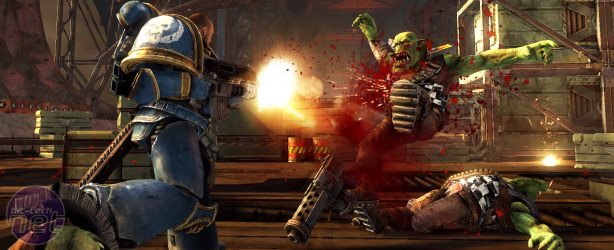The Games Workshop
In this video we can see the earliest iteration of Space Marine. Between the ridiculous marketing phrases the narrator spouts when he’s not shifting the paradigm and thinking outside the megacube, the footage shows a game with plenty of differences compared to what Relic eventually released - stunningly because Relic didn't make it.“There was another game dubbed Space Marine originally being developed by a different studio and that reel shows off their work," says Bergen. "That game was cancelled. When we started work on our version, we did so from scratch. We saw the video like everyone else and I’m pretty sure we even had a playable version of it, but it wasn’t what we were looking to do with the franchise.
Everything in the game that was published is 100 per cent Relic; the combat, the story the art etc... We didn’t take anything from that reel. The executions for instance come from our RTS games which have always featured sync-kills.”
The projects are deceptively similar in a lot of ways, but fundamentally it’s the attitude and approach that separates them. Superficially, they both encompass the scale that 40K demands and the shared execution system is notable too - though Relic’s version isn't woefully labelled as a Cinemaction Moment.
It's the differences which are more profound, however. The reel version, for example, utterly lacks ranged combat, while Relic made that an integral part of the game.
In place of Relic’s Fury meter also is the use of ‘Overkill’ tokens which enable ‘Overkill Mode'; a minigame which involves first person perspective struggling with Chaos Space Marines. Overkill Mode manages to combine the constant threat of quicktime events popping up throughout combat with unnecessary gratuity in a game that is already hyper-violent.
The real question here though isn't 'what's different?' or 'what's similar?', but; ‘what if?’
What if the reel version of Space was never cancelled? Based on the environment seen in the footage, it seems to most resemble a hive world rather than the forge world Relic opted for. Hive cities are supposed to house billions of citizens, suggesting that that version of the game would have had a more lively and inhabited feel than Relic's bystander-less version.
The focus on melee at the cost of the ranged element, in contrast to the balance between the two that the Relic version had, would’ve been a massive disservice to the universe it was supposed to portray, however.
“Ranged combat is a means to an end,” Mr. Narrator says at the reel’s start, in case there was any doubt that bringing a pistol sized rocket launcher is less tactically sound then charging your enemies with a futuristic hedge trimmer.
The melee combat system itself, barring minor differences seems near identical to Relic’s at its core, though slower paced and less frenetic. Add this to the light sprinkling of foes compared to Relic’s literal armies and it only compounds the problem.
The presence of the ‘parry system’ is a good indicator of the direction the combat system might have taken; instead of a fluid counter it would have introduced a sharp stop to the flow of melee. Taking human shields may have been an enjoyable addition, but again ascribes weakness to an army defined by its potence.
For all the obvious mechanical similarities, it’s the presentation really makes the two games seem so different. The marine in the reel version seems weightless even despite the colossal armour, and the in-game camera is all too eager to jump into slow motion cinematic mode. It's a far cry from the version that Relic would eventually put together and casts that version in favourable light even despite the lack of vehicles and populace.

MSI MPG Velox 100R Chassis Review
October 14 2021 | 15:04












Want to comment? Please log in.